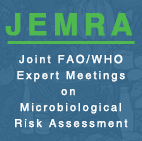 |
Risk Assessment for Cronobacter sakazakii in Powdered Infant Formula |

 |
|
|
|
|
|
|
|
Step |
Temperature (ºC) |
Duration (hours) |
Holding Conditions |
|
Preparation of Formula
|
The ambient temperature of the location of the formula during reconstitution. This will most likely be the temperature of the room where powder is reconstituted.
|
The length of time from the start to the end of the reconstitution process. This does not include any time where the formula is left to stand once the powder has been mixed with the re-hydrating liquid.
|
Select the holding conditions that apply from the drop-down list. This list is the same for all components of a scenario where holding conditions apply. Choose from
Still air and bottle : this would reflect a situation where the formula is prepared in a container that need not necessarily be a single bottle, but holding occurs in single bottles. There is no standing time in a container other than a single bottle.
Still air and 1L container : this is used when preparation of the formula occurs in a large container and the prepared formula remains in this container until the time for feeding. This does not apply to preparation of a batch of formula that is subsequently dispensed into smaller batches (for example single bottles or cups) and stored in these smaller batches without immediate feeding.
Convection : this would represent the use of forced convection, and particularly applies to cooling. For example use of a refrigerator that uses forced cool air as opposed to still air)
Rapid Cooling : this would reflect forced cooling for example by the use of an ice bath or holding the bottle under running cold water.
|
|
Holding/Cooling |
The ambient temperature of the location of the formula during any holding or cooling that occurs prior to the preparation of the formula for feeding. For example, if the formula is cooled in a refrigerator this will be the temperature of the refrigerator. If the formula is held at room temperature prior to feeding this will be the ambient temperature of the room. |
The length of time for which the prepared formula is held/cooled prior to the preparation of the formula for feeding. For example, if the prepared formula is stored in a refrigerator, this is the amount of time of refrigeration. |
|
Active Re-warming/Cooling |
The temperature to which the formula is re-warmed or cooled in preparation for feeding. This will be the temperature at which the formula is intended to be fed to the infant. |
The length of time the process of active re-warming/cooling takes in preparation for feeding. Note that the model will assume that the temperature specified for the end of active re-warming/cooling will be reached in the amount of time specified here. |
|
Feeding Period |
The ambient temperature of the location of feeding. This will most likely be the temperature of the room where feeding occurs. |
The length of time from the start to the end of the feeding period. |
|
|
|
|
|
|
|
|
|
|